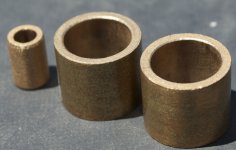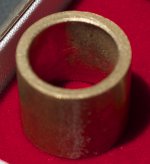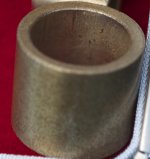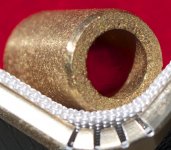The AM040706 bearing is not available from McMaster-Carr here in the USA. (I looked) These will probably have to be sourced from the UK or perhaps another distributor here in the USA.
The dimensions are as follows:
ID: 4mm
OD: 7mm
Length: 6mm
http://www.getyourbearings.co.uk/plain-oilite/am040706.html
The dimensions are as follows:
ID: 4mm
OD: 7mm
Length: 6mm
http://www.getyourbearings.co.uk/plain-oilite/am040706.html
The AM040706 bearing is not available from McMaster-Carr here in the USA. (I looked) These will probably have to be sourced from the UK or perhaps another distributor here in the USA.
The dimensions are as follows:
ID: 4mm
OD: 7mm
Length: 6mm
AM040706 Plain Metric Oilite Bearing - GetYourBearings.co.uk
Kevinkr - thanks. I did a search and never found it anywhere. As I mentioned in a previous post, what bearings I got as part of a kit seem a bit loose to me, so I'm looking for specs and a direct source to replace them all. If you've got specs on spindle, idler wheel and motor bearings, I'd sure appreciate if you could pass them on. Thanks.
I wasn't able to find this bushing on the Oilite product page. I did find an AAM 407-4 and an AAM407-8
In the UK AM0407-6 Oil Filled Bronze Plain Bush 4x7x6mm Simply Bearings Ltd
Kevinkr - thanks. I did a search and never found it anywhere. As I mentioned in a previous post, what bearings I got as part of a kit seem a bit loose to me, so I'm looking for specs and a direct source to replace them all. If you've got specs on spindle, idler wheel and motor bearings, I'd sure appreciate if you could pass them on. Thanks.
One thing to consider is the softness of the Oilite bushing material. .....And it is very soft material.......Prior to installation into the housing, the bushing may seem slightly loose when test fit over the shaft it is meant to fit. However, after the bushing has been pressed into the housing, that clearance you noticed when the bushing was loose is now closer to proper.
In my 'main bearing' experiments, I've found that .001" of press between housing diameter and the bushing OD equates into an almost direct .001" reduction in bushing ID size once the bushing gets pressed in.
They do shrink upon installation, and depending upon the amount of the interference fit.
-Steve
Volken - Thank you. I see there's quite a difference in price between your UK source and the UK source Kevinkr found. The specs are the same, but I wonder if they're from the same manufacturer. I would want to get the best available - price here isn't that important.
Volken - Thank you. I see there's quite a difference in price between your UK source and the UK source Kevinkr found. The specs are the same, but I wonder if they're from the same manufacturer. I would want to get the best available - price here isn't that important.
I believe the one I sourced is exactly the same, note the use of the Oilite registered trademark. I don't have information on any of the other bushings, but you can measure and using the recommended manufacturer guidelines choose the correct size. Note that motor bearings are quite specific to this motor and the only sources I have found are already posted elsewhere in this thread.
Hi ,
I found them here,
AM0407-6 Oil Filled Bronze Plain Bush 4x7x6mm Simply Bearings Ltd
Sorry was already mentioned
Regards Ronald,
Onwer of 5x TD124 1x TD121 1xTD111 1xTD134 all working like a charme.
Restored all by my self
I found them here,
AM0407-6 Oil Filled Bronze Plain Bush 4x7x6mm Simply Bearings Ltd
Sorry was already mentioned
Regards Ronald,
Onwer of 5x TD124 1x TD121 1xTD111 1xTD134 all working like a charme.
Restored all by my self
Last edited:
One thing to consider is the softness of the Oilite bushing material. . . . They do shrink upon installation, and depending upon the amount of the interference fit.
-Steve
Steve - thanks. very good point I hadn't considered. I have additional concerns about these bushings. They came to me as part of a kit someone said they had lying around, couldn't identify the source of the kit, nor confirm what each bushing was for. Two are for the main spindle and I suspect the third is for the idler wheel.
While I understand sintered bronze is porous, and admit I've never studied anything made of the material before, I see black pitting and some other marks on the inside of the spindle bushings, as well as indications of some smearing on the inside half of one (really looks like half got tooled differently, don't know how else to explain it). Smearing, from what I've read, is the outcome of a bad tooling job when they're cut. Of them all, the idler wheel bushing to my eye looks better, newer, from a different manufacturer. Also, if they were oil filled at time of manufacture, I certainly can't feel it. I'm attaching some photos for clarification.
What I really want to do is figure out the right specs, based on OEM or by putting a micrometer on each spindle and going from there. I understand there are people selling parts online and that some people have had good luck that way (mixed bag for me), but I want to know what I'm buying is properly sized, not take someone else's word for it.
Here's a page with photos I've been using to better understand good and bad sintered bronze.
http://www.lm-tarbell.com/machining_sintered_bronze.htm
Attachments
Last edited:
Sizing is a valid concern as I have had problems with spindle bearings from several sources. I've purchased fully assembled spindle bearing assemblies at considerable cost that were a bit too tight, and have bought the bushings from several sources which invariably have fit the bore of the bearing assembly loosely enough that when I add oil bushings move from where I installed them due to hydrostatic pressure as the spindle seats. (these ones at least seem to work otherwise ok) Do not use loctite or other similar lockers as I am relatively certain the stuff will wick into the bearing to some extent and probably ruin it.
My TD-124/II had so few hours that I did not need to replace any bushings, although I did replace the motor bushings which I have to some extent regretted as noted in older posts. No problems now however. And I am listening right now.
Genuine oilite sleeve bearings will usually come already oil impregnated, but sintered bronze (non oilite brand) generics may or may not.
My TD-124/II had so few hours that I did not need to replace any bushings, although I did replace the motor bushings which I have to some extent regretted as noted in older posts. No problems now however. And I am listening right now.
Genuine oilite sleeve bearings will usually come already oil impregnated, but sintered bronze (non oilite brand) generics may or may not.
I believe the one I sourced is exactly the same, note the use of the Oilite registered trademark. I don't have information on any of the other bushings, but you can measure and using the recommended manufacturer guidelines choose the correct size. Note that motor bearings are quite specific to this motor and the only sources I have found are already posted elsewhere in this thread.
Kevinkr - On the one you pointed to, I noticed the registered trademark and a "stop fake bearings" link to a trade association. I didn't see any mention of Oilite on the one Volken pointed to, which I thought odd considering that was the higher priced of the two. I really want to do this right first time, although based on what you've gone through, I'm not sure that will happen unless I just get very lucky. - and a plus for Oilite. I noted in one description that they use turbine oil in theirs.
I've purchased fully assembled spindle bearing assemblies at considerable cost that were a bit too tight, and have bought the bushings from several sources which invariably have fit the bore of the bearing assembly loosely enough that when I add oil bushings move from where I installed them due to hydrostatic pressure as the spindle seats.
OK, between my getting what in my opinion are some pretty poor bushings and the kinds of experiences you've had, I figured sending an e-mail to LM-Tarbell explaining what these bushings are used for, in hopes I can get a dialogue started that might result in a custom solution. I'm not thinking of this just for me. Seems there are plenty of people who could benefit if a consistent, good quality set of bushings could be sourced. If they happen to be custom-made in the USA, well all the better far as I'm concerned.
Yes, I think that would be a worthwhile endeavor, possibly rather expensive. To do it right they would probably need the precise OD of the spindle and the ID of the bearing well. Next time I have one apart I will post measurements. Good to have a few to determine tolerance spread.
Yes, I think that would be a worthwhile endeavor, possibly rather expensive. To do it right they would probably need the precise OD of the spindle and the ID of the bearing well. Next time I have one apart I will post measurements. Good to have a few to determine tolerance spread.
I was hoping you might decide do exactly that, and yes, putting a good micrometer to several samples makes a lot of sense. I'm not a machinist, but what I've read about micrometers also suggests not everyone can operate one properly and that in different hands different numbers can be obtained, so those variables would have to get nailed down.
Sure, any kind of custom solution won't be as cheap as what one can get off-the-shelf, but it might not be unreasonable. Just have to see if I get a reply from them.
Steve - thanks. very good point I hadn't considered. I have additional concerns about these bushings. They came to me as part of a kit someone said they had lying around, couldn't identify the source of the kit, nor confirm what each bushing was for. Two are for the main spindle and I suspect the third is for the idler wheel.
While I understand sintered bronze is porous, and admit I've never studied anything made of the material before, I see black pitting and some other marks on the inside of the spindle bushings, as well as indications of some smearing on the inside half of one (really looks like half got tooled differently, don't know how else to explain it). Smearing, from what I've read, is the outcome of a bad tooling job when they're cut. Of them all, the idler wheel bushing to my eye looks better, newer, from a different manufacturer. Also, if they were oil filled at time of manufacture, I certainly can't feel it. I'm attaching some photos for clarification.
What I really want to do is figure out the right specs, based on OEM or by putting a micrometer on each spindle and going from there. I understand there are people selling parts online and that some people have had good luck that way (mixed bag for me), but I want to know what I'm buying is properly sized, not take someone else's word for it.
Here's a page with photos I've been using to better understand good and bad sintered bronze.
machining sintered bronze
re: sizing and correct installation.
The material is soft enough that it is possible to severely distort the shape of the bushing if, when it is pressed in, the bushing isn't adequately squared up to the bore it is to fit into. And that can mess with the final ID size of the bushing. So, I have learned to take pains to adequately square the bushing prior to the application of force. typically, I use a pilot shaft that fits within the bushing and helps to guide the bushing during the press-in operation. For a pilot shaft on the main platter bushings, I use a spare spindle shaft.
re: correct appearance of the Oilite bronze. As you note, the material should not become smeared during the machining operation, or the bushing will not have the "self lube" ability during operation. In your 4 photos, I think I don't see evidence of smearing. Typically, hand polishing to size should be avoided on this material, as that will smear the surface finish!
That last photo to the right is probably a bushing that I would not install. Like it is made of tiny bronze balls. That appears to be a bad casting. (I think) There is another one that shows some dark pits within the surface of the ID. That is actually normal and OK. If you were to section cut one of these bushings and magnify the cross section at the cut, you'd see plenty of large pores like that one. Features like that are normal and necessary to the function of this type of bushing.
-Steve
TD124 Motor Failure
Hi everyone,
this is my first post, as I've just signed up to benefit from all this knowhow! Apologies if I'm posting in the wrong thread - please point me in the right direction if so.
My problem is a dead TD 124 mk1 motor (E50) and my question: can anything be done?
The TT was in use for a couple of years after I cleaned it up and swapped some grommets with overpriced Schopper replacements (although I did not clean out the motor since it was getting up to and maintaining speed just fine, as well as running quietly, after I lubricated the spindle).
For the last couple of years I have not used this venerable Thorens since it was supplanted in our system by a Garrard 301 (could the problem be injured pride?). I then fired it up a few days ago and all was well, decided to let it run for a while to shake off any cobwebs and forgot about it until the next day, when I noticed the strobe was still on but the platter had stopped spinning.
Despite being an electronics imbecile I de-soldered the motor from the board and believe I have tested it correctly (green ones together, since I'm in the UK, and red ones to a a lamp-cord lead each) and ascertained that there is no life.
Is there any hope?
Kind regards,
Finnur
Hi everyone,
this is my first post, as I've just signed up to benefit from all this knowhow! Apologies if I'm posting in the wrong thread - please point me in the right direction if so.
My problem is a dead TD 124 mk1 motor (E50) and my question: can anything be done?
The TT was in use for a couple of years after I cleaned it up and swapped some grommets with overpriced Schopper replacements (although I did not clean out the motor since it was getting up to and maintaining speed just fine, as well as running quietly, after I lubricated the spindle).
For the last couple of years I have not used this venerable Thorens since it was supplanted in our system by a Garrard 301 (could the problem be injured pride?). I then fired it up a few days ago and all was well, decided to let it run for a while to shake off any cobwebs and forgot about it until the next day, when I noticed the strobe was still on but the platter had stopped spinning.
Despite being an electronics imbecile I de-soldered the motor from the board and believe I have tested it correctly (green ones together, since I'm in the UK, and red ones to a a lamp-cord lead each) and ascertained that there is no life.
Is there any hope?
Kind regards,
Finnur
New motor coils
Hello,
If your MkI motor coils are shot you can get MkII coils from
audiosilente.com
Good Luck
David
An externally hosted image should be here but it was not working when we last tested it.
Hello,
If your MkI motor coils are shot you can get MkII coils from
audiosilente.com
Good Luck
David
Can you spin the pulley by hand or has the motor seized?
You can measure the DCR of the motor windings - a good motor set for 200 - 250V operation should measure somewhere around 330 ohms..
As pointed out in the previous post you can purchase replacement motor windings. The motor at this juncture should be completely rebuilt.
Another option would be to purchase a good E50 on eBay and rebuild that. They are quite common.
These motors run hot enough in normal operation I would be very leery of leaving them running continuously over say a 24 hour period. I have two of these tables and a spare motor.. 😀
You can measure the DCR of the motor windings - a good motor set for 200 - 250V operation should measure somewhere around 330 ohms..
As pointed out in the previous post you can purchase replacement motor windings. The motor at this juncture should be completely rebuilt.
Another option would be to purchase a good E50 on eBay and rebuild that. They are quite common.
These motors run hot enough in normal operation I would be very leery of leaving them running continuously over say a 24 hour period. I have two of these tables and a spare motor.. 😀
Many thanks for the helpful replies.
I managed to get in touch with Martin Bastin here in the UK and he has kindly offered to repair the motor for me, as he said he might have the spare parts necessary.
I shall take on board the tip about the motor over-heating - I didn't know this was a problem with the 124.
Thank you also for the useful link to the Italian website.
I will learn how to use an ohmmeter one of these days...
Kind regards,
Finnur
I managed to get in touch with Martin Bastin here in the UK and he has kindly offered to repair the motor for me, as he said he might have the spare parts necessary.
I shall take on board the tip about the motor over-heating - I didn't know this was a problem with the 124.
Thank you also for the useful link to the Italian website.
I will learn how to use an ohmmeter one of these days...
Kind regards,
Finnur
Is it normal for the E50 to hang lower from one the three bushings? My top plate under the motor pulley is also loose.
The top plate floats on the three mounting posts and is not otherwise secured. Just push it as far down as it goes.
I don't quite follow the comment about the bushings. The motor should sit level, usually if it does not it means the belt tension is too high or the motor was not properly reassembled if it was taken apart.
A picture is worth 1000 words. 😀
I don't quite follow the comment about the bushings. The motor should sit level, usually if it does not it means the belt tension is too high or the motor was not properly reassembled if it was taken apart.
A picture is worth 1000 words. 😀
- Home
- Source & Line
- Analogue Source
- Restoring and Improving A Thorens TD-124 MKII



